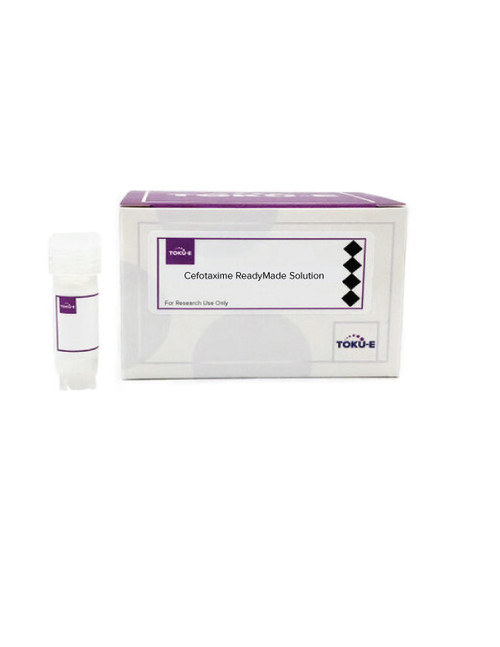Erythromycin ReadyMade™ solution is provided as a sterile-filtered solution of Erythromycin formulated in water at a concentration of 1 mg/ml. It has been filter-sterilized using a 0.22 μm filter.
Erythromycin is a broad-spectrum macrolide antibiotic derived from Saccharopolyspora erythraea (formerly Streptomyces erythraeus) that inhibits bacterial protein synthesis. It is composed largely of Erythromycin A, with small amounts of Erythromycin B and C.
| Mechanism of Action | Macrolide antibiotics inhibit bacterial growth by targeting the 50S ribosomal subunit preventing peptide bond formation and translocation during protein synthesis. Resistance to Erythromycin is commonly attributed to mutations in 50S rRNA preventing erythromycin binding allowing the cell to synthesize proteins free of error. |
| Spectrum | Erythromycin is a broad-spectrum antibiotic targeting Gram-negative and Gram-positive bacteria. It is also effective against Mycoplasma, Mycobacteria, and spirochetes. |
| Plant Biology Applications | Erythromycin has been used in combination with nystatin and streptomycin for eliminating contaminants in rubber (Hevea brasiliensis) tissue culture (Leiffert et al, 1991). |
| Microbiology Applications | Erythromycin is commonly used in clinical in vitro microbiological antimicrobial susceptibility tests (panels, discs, and MIC strips) against Gram-positive, Gram-negative, and Mycoplasma species. Medical microbiologists use AST results to recommend antibiotic treatment options. Representative MIC values include: Mycoplasma pneumoniae 0.0019 µg/mL – 0.0078 µg/mL Legionella pneumophila 0.008 µg/mL – 1 µg/mL For a representative list of Erythromycin MIC values, click here. |
| Eukaryotic Cell Culture Applications |
There is growing evidence that Erythromycin has anti-inflammatory properties and can be used to ameliorate airway inflammation. Using adult human T-cell leukemic cell line (Jurkat; clone E6-1), researchers found that Erythromycin could inhibit cytokine gene expression (specifically IL-8 gene) in T-cells and this mechanism is at the level of transcriptional regulation (Aoki and Kao, 1999). Erythromycin A is a potent stimulator of gastrointestinal motor activity. In vitro studies suggest that it mimics motilin, a peptide that stimulates motor activity in human and rabbit cells via smooth muscle receptors (Peeters et al, 1989). The anti-inflammatory action of Erythromycin was evaluated by looking at isolated neutrophils from human blood. When Erythromycin was applied, it shortened neutrophil survival in a dose-dependent way, with maximum effect at 10 mg/ml and above. It shortens neutrophil survival in part through elevating cAMP (cyclic AMP) levels. The result was accelerated apoptosis. Apoptosis may limit tissue injury by marking senescent neutrophils for phagocytosis and degradation by macrophages and by inhibiting the capacity of neutrophils to make injurious responses to inflammatory mediators (Aoshiba et al, 1995). |
| Cancer Applications |
HERG (Human Ether-a-go-go Related Gene) may serve as a molecular marker and modulating target for individualized cancer therapy. Erythromycin, active as modulator and a HERG K+ channel blocker, suppressed the growth of various cancer cells and the potency was correlated with HERG expression levels. Erythromycin also enhanced the G2/M arrest induced by vincristine in HT-29 cells (Chen et al, 2005). Erythromycin modulated growth factor-induced expression of heparanase mRNA on human lung cancer cells in vitro. The activity of heparanase is associated with metastatic of many cancer cells but little is known about the factors that induce its activity in cancer cells. The effect of Erythromycin on its expression of heparanase mRNA induced by growth factors (platelet-derived growth factor (PDGF), hepatocyte growth factor (HGF) and basic fibroblast growth factor (bFGF). Erythromycin modulated the induction of these grwoth factors. This suggests that these growth factors can induce heparanase in potentially metastatic cancer cells (Sasaki et al, 2001). The ability of cancer cells to be resistant to multiple anticancer drugs is a phenomenon called multidrug resistance. This involves the Multidrug Resistance Protein (MRP), which also acts as a drug efflux pump. This protein is found in normal human tissues, and transports many anionic substrates. Researchers examined the effects of Eythromycin and 11 other antimicrobial agents on MRP. Only Erythromycin and Ofloxacin enhanced sensitivity which resulted in an accumulation of vincristine intracellularly. This suggests they could be substrate for MRP and may competitively inhibit MRP function as a drug efflux pump (Terashi et al, 2000). Erythromycin's antitumor effects were studied in neuroblastoma cells (SH-SY5Y) at different concentrations and durations. It was found that it could inhibit cell proliferation in a concentration- and time-dependent manner (Yongsheng et al, 2011). |
| Molecular Formula | C37H67NO13 |
| References |
Aoki Y and Kao PN (1999) Erythromycin inhibits transcriptional activation of NF-kappaB, but not NFAT, through calcineurin-independent signaling in T cells. Antimicrob. Agents Chemother. 43(11):2678-2684 PMID 10543746 Aoshiba K, Nagai A, and Konno K (1995) Erythromycin shortens neutrophil survival by accelerating apoptosis. Antimicrob. Agents and Chemother. 39(4):872-877 PMID 7785987 Chen S, Jiang M and Zhen Y (2005) HERG K+ channel expression-related chemosensitivity in cancer cells and its modulation by Erythromycin. Cancer Chemother Pharmacol 56: 212-220. PMID 15812674 Lovmar M and Tenson T (2003) The mechanism of action of macrolides, lincosamides and Streptogramin B reveals the nascent peptide exit path in the ribosome. Molec. Microbiol 330(5 ):1005-1014 PMID 12860123 Leifert C, Ritchie JY and Waites WM (1991) Contaminants of plant-tissue and cell cultures. World J. Microbiol. Biotechnol. 7: 452469 Oliynk M et al (2007) Complete genome sequence of the Erythromycin-producing bacterium Saccharopolyspora erythraea NRRL233338. Nature Biotechnol. 25:447-453 PMID 17369815 Peeters T et al (1989) Erythromycin is a motilin receptor agonist. Am. J. Physiol 257 (3):G470-G474 PMID 2782416 Sasaki M et al (2001) Erythromycin and clarithromycin modulation of growth factor-induced expression of heparanase mRNA on human lung cancer cells in vitro. Mediators of Inflammation. 10 (ID 842031) 9pp. Terashi K et al (2000) Interactions of Ofloxacin and Erythromycin with the multidrug resistance protein (MRP) in MRP-overexpressing human leukemia cells. Antimicrob. Agents Chemother. 44(6):1697-1700 Yongsheng J et al (2011) Antitumor activity of Erythromycin on human neuroblastoma cell line (SH-SY5Y). J. Huazhong Univ. Sci. Technol. [Med. Sci.] 31:33–38 |







